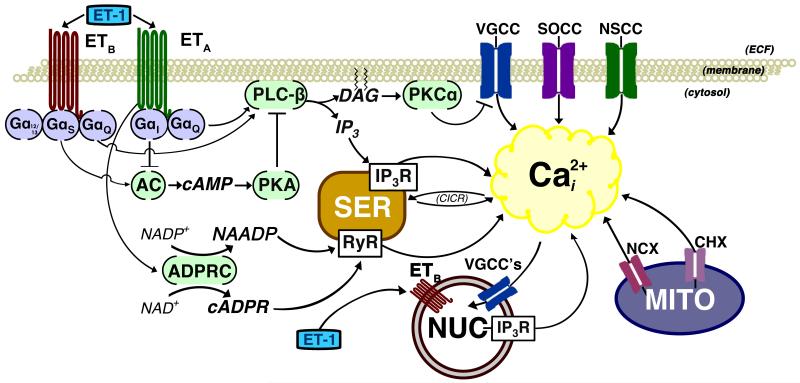Figure 1.
This cartoon illustrates mechanisms that are linked to ET receptor-dependent increases in [Ca2+]i. In addition to the plasma membrane receptors, ETB receptors in the nuclear membrane may mobilize calcium when activated by cytosolic ET-1. While the ETA receptor is shown only in the plasma membrane, ETB receptors are found in both the plasma and nuclear membranes. It is unknown if ETA receptors are in the membrane of other organelles. Many of the same mechanisms are attributed to both ETA- and ETB-dependent increases in [Ca2+]i. Arrows represent activation; teed lines represent inhibition. Abbreviations: AC, adenylate cyclase; ADPRC, ADP-ribosyl cyclase; cADPR, cyclic ADP ribose; cAMP, cyclic adenosine monophosphate; CHX, calcium/hydrogen antiporter; CICR, calcium-induced calcium release; DAG, diacylglycerol; ECF, extracellular fluid; ET-1, endothelin-1; IP3, inositol trisphosphate; IP3R, inositol trisphosphate receptor; MITO, mitochondria; NAADP, nicotinic acid adenine dinucleotide phosphate; NAD+, nicotinamide adenine dinucleotide; NADP, nicotinamide adenine dinucleotide phosphate; NCX, sodium/calcium exchanger; NSCC, non-selective cation channel; NUC, nucleus; PKA, protein kinase A; PKCα, protein kinase C-α; PLC-β, phospholipase C-β; RyR, ryanodine receptor; SER, smooth endoplasmic reticulum; SOCC, store-operated calcium channel; VGCC, voltage-gated calcium channel.

